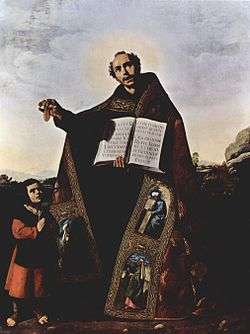Romanus of Caesarea
Saint Romanus of Caesarea (also known as Romanus of Antioch) is venerated as a martyr. In 303 or 304, at the beginning of the Diocletian persecution, a deacon called Romanus of Caesarea in Palestine suffered martyrdom at Antioch. He was taken prisoner, was condemned to death by fire, and was bound to the stake; however, as Emperor Galerius was then in Antioch, Romanus was brought before him. At the emperor's command Romanus' tongue was cut out. Tortured in various ways in prison he was finally strangled.
Saint Romanus of Caesarea | |
|---|---|
 Saints Romanus and Barulas, by Francisco de Zurbarán. The book says, in Latin, "Blessed Romanus was praying when he said, Lord Jesus Christ, show thy might, that thy holy name may be glorified, which is blessed forever. Pray for us blessed Romanus, that we may be made worthy of the promises of Christ." | |
| Died | c. 303 AD |
| Venerated in | Roman Catholic Church, Eastern Orthodox Church |
| Feast | November 18, August 9 (Traditional Catholics) |
Eusebius speaks of his martyrdom in De martyribus Palaestinae. Prudentius[1] relates other details and gives Romanus a companion in martyrdom, a Christian by name Barulas. On this account several historians, among them Baronius, consider that there were two martyrs named Romanus at Antioch, though more likely there was but the one whom Eusebius mentions. Prudentius has introduced legendary features into his account, and his connection of the martyrdom of Barulas with that of Romanus is probably arbitrary.
The feast day of St. Romanus is observed on 18 November.[2] Barulas, like St. Quiricus, is venerated as a child-martyr. The church of San Román in Seville is dedicated to Romanus. Prudentius wrote a 1140 line hymn to Romanus, the Romane Christi fortis, the tenth hymn in his Peristephanon.[3]
_-_relic_of_Romanus_of_Caesarea.jpg)
Sources
Notes
- Peristephanon, X in P.L., LX, 444 sqq. or page 235 of this PDF
- cf. Paul Allard, "Histoire des persécutions", IV, 173 sq.; Quentin, "Les martyrologes historiques" (Paris, 1908), 183-5
- Romane Christi in the Gopher archive at the University of Pennsylvania
![]()